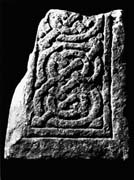Select a site alphabetically from the choices shown in the box below. Alternatively, browse sculptural examples using the Forward/Back buttons.
Chapters for this volume, along with copies of original in-text images, are available here.
Object type: Lower part of cross-shaft [1]
Measurements: H. 35 cm (13.75 in); W. 29.6 > 27 cm (11.6 > 10.6 in); D. 12.7 cm (5 in)
Stone type: Fine-grained, very pale brown (10YR 8/4), non-calcareous sandstone, with some mica flakes; deltaic channel sandstone, Saltwick Formation, Aalenian, Middle Jurassic; from North Yorkshire Moors
Plate numbers in printed volume: 824-5,827-8
Corpus volume reference: Vol 3 p. 216-217
(There may be more views or larger images available for this item. Click on the thumbnail image to view.)
A (broad): The very broad, flat edge moulding extends along the base of the panel as well as the sides. Within it is a flat inner moulding. It contains a panel of one register and part of another of surrounded closed circuit pattern F interlace, using broad, flat strands, the terminals of the loose strands having arrow-head tips tucked into the corner of the panel. It is densely packed with pellet fillers down the side.
B (narrow): The edge moulding is flat and plain, and is continued more widely along the base. There is a thin, plain inner moulding to the single panel, which contains a free ring and diagonals, separated from a Stafford Knot terminal at the bottom by an immensely long glide. The pattern is incised with a single line.
C (broad): The flat edge moulding is wide and is extended more broadly across the base. There is an inner flat moulding containing surrounded alternating half pattern C interlace with bar terminal at the bottom, using broad, flat strands. Pellets act as fillers at the sides.
D (narrow): Very damaged, but the Stafford Knot terminal and beginnings of a glide in incised technique suggest that it was identical with the pattern on face B.
The restriction of the ornament to interlace patterns is typical of most of the sculpture at Stonegrave which generally eschews formalized animal art. The patterns of this piece are more complex than those of the near-by Anglo-Scandinavian plaits, and are in line with Anglian designs. The flat, dense strands with pellet fillers and the tendency towards closed circuit patterns shows that Anglo-Scandinavian fashion had its roots in such late Anglian designs. The nearest parallel to the strand type is the architectural fragment Kirkbymoorside 6 (Ill. 536). The incised work on the side resembles Levisham 3 (Ills. 644–7), and Wharram Percy 1 (Ill. 872), both pre Viking-age pieces. It is also found on Lindisfarne 10A, Northumberland (Cramp 1984, I, 198–9, fig. 19, II, pl. 194, 1088).



